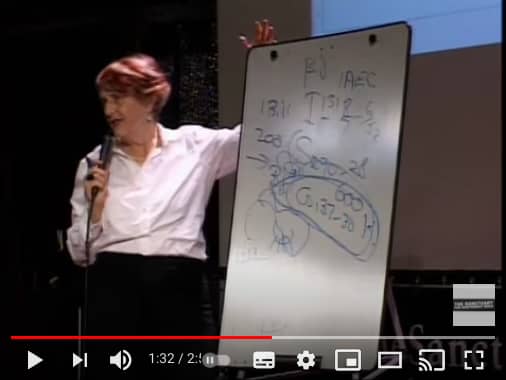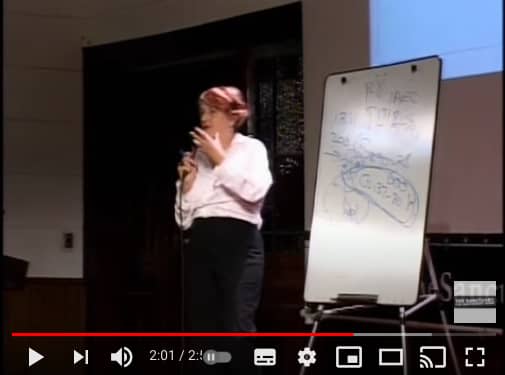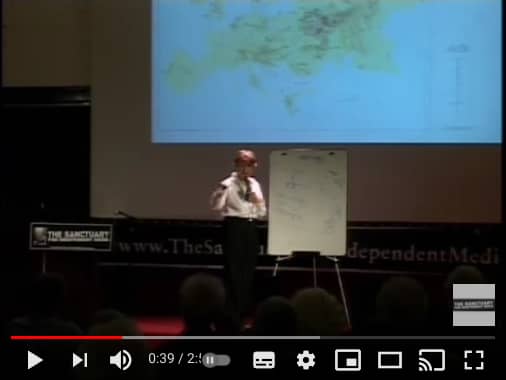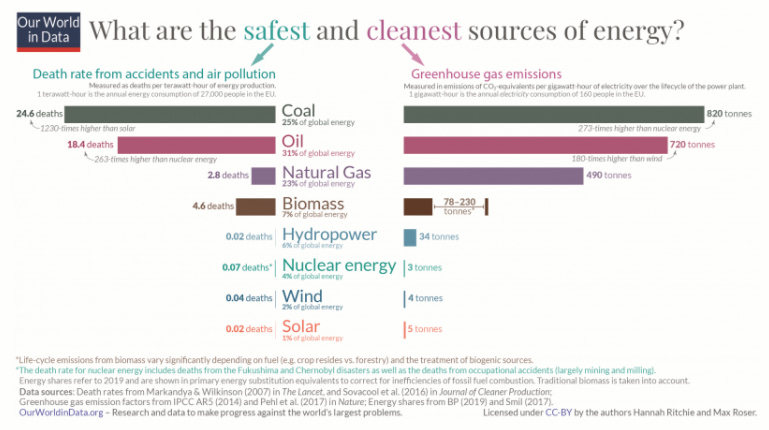The Chernobyl meltdown of 1986 was a landmark event in nuclear history. Contrary to the Fukushima incident, Chernobyl was caused by a lack of caution and safety procedures. On April 26th, an operator attempted to shut off a faulty nuclear reactor. When the reactor was subjugated to the control rods that were supposed to shut it off, the reaction between the hot metal and cooling water generated fuel fragmentation and steam. This raised the pressure in the fuel reactor and kickstarted a chain reaction of explosions throughout the facility. The results of this incident were a disaster, and one that would not soon be forgotten. The Chernobyl incident has been a talking point of virtually every nuclear energy debate since, and has led to strong opposition of nuclear power.
One of these activists against nuclear energy is Dr. Helen Caldicott, a physician and public speaker who advocates against the use of nuclear energy. In her speech at The Sanctuary for Independent Media, Caldicott claims that nuclear energy is dangerous, unethical, and has caused a “medical coverup” in an attempt to sell more nuclear power plants. However, nuclear energy is not the world ending catastrophe that she claims it to be. In fact, nuclear energy is one of the safest, and by far the most efficient energy source currently known. Although no energy source is without its flaws, nuclear energy is a far better alternative to the growing threat of fossil fuels and climate change. Nuclear fission and fusion is able to provide clean energy with a fraction of the byproducts from burning fossil fuels. In comparison to renewables, nuclear energy is not fully sustainable. In time, renewable energy sources are going to be necessary for the future of the planet, but current renewable technology is not at a point in which it can fully take over as a primary energy supplier. That is where nuclear energy plays a crucial role in energy production. Nuclear energy is a safe and effective alternative to fuel that can serve as a stepping stone to a fully renewable future.
1. “They cost 12 to 15 billion to build” (0:13)
Dr. Helen Caldicott’s first disputable claim is the cost to build these new nuclear reactors. She claims that the cost of one new nuclear power plant is around “$12-15 billion”. She deliberately overplays the cost of nuclear plants in an effort to portray nuclear energy as unreasonable. Although the average cost of nuclear power plants is extremely difficult to calculate due to a number of issues regarding safety protocols, inflation, and cost overrun, an estimate from Synapse Energy placed the average cost of nuclear energy power plants at “$7 to $9 billion per unit.”
Even so, these numbers are relatively high compared to other energy sources. The high prices for these units are dependent on a number of variables, but one of the most prominent is the legacy nuclear energy has left behind. Negative bias towards nuclear energy can raise the price of these plants exponentially. Another factor leading to these high prices is the many safety protocols in place at these nuclear power plants. Global competition for the resources needed to build the plants have also caused a spike in price. For example, two decades ago there were about 400 suppliers of nuclear plant components. Today, there are fewer than 80 suppliers in the U.S. according to the Nuclear Regulatory Commission. Although these prices are high, they are still a far cry from the numbers Caldicott predicts.
2. Dr. Helen Caldicott as an expert
Another issue that arises from Dr. Caldicott’s analysis on nuclear power is her qualifications in regards to being an expert. Dr. Helen Caldicott graduated from the University of Adelaide in Australia with the American equivalent of an M.D. This is where her expertise lies; as a physician. Although Dr. Caldicott’s achievements as a physician are respectable, a physician is very different from a physicist. Dr. Caldicott has no history in the nuclear field besides her obstinate opposition to nuclear energy through her activism. Dr. Caldicott also mentions in the video how she was a physician at Harvard. The mention of Harvard Medical School also serves to paint her as an expert on the study since Harvard is a prestigious school. Although attending Harvard is an impressive feat, her stay had nothing to do with nuclear energy. Instead, her three year fellowship with Harvard was in nutrition and pediatrics.
Dr. Caldicott has also written books on nuclear energy as well as being featured in the film If You Love This Planet, which was declared as “political propaganda” by the United States Department of Justice. Although her relation with Harvard as well as holding the title of doctor may make Caldicott seem as a credible expert, her experience in nuclear physics is nonexistent. Instead, Dr. Caldicott is able to rely on her position as a physician to appear trustworthy as a nuclear energy informant.

3. “Nearly a million people have already died from Chernobyl” (1:49)
Another claim that Caldicott makes is that nearly a million people have died from the Chernobyl incident. Not only is this a faulty estimate, it is a blatant lie. Although the disaster at Chernobyl was a tragedy, this number incorrectly reflects the number of those who have perished. A study conducted by the International Atomic Energy Agency placed the number of deaths caused by Chernobyl at only around 4,000. Although this number is on the smaller side of estimates, it is significantly less than the number stated by Dr. Helen Caldicott.
A more liberal estimate of deaths caused by Chernobyl comes from Greenpeace Europe’s study The Other Report on Chernobyl. Greenpeace, a group of radical environmentalists who have staunchly opposed nuclear energy, claims that 60,000 people were killed by Chernobyl. It is also important to mention that these estimates include not only those that have died, but those who are predicted to die due to health complications caused by the radiation of Chernobyl.
The one million deaths predicted by Caldicott is not only wrong, but makes a mockery of the independent studies as well as government supported studies that have involved years of data gathering. The reason Dr. Caldicott chose such a high number of deaths is simple, to overplay the dangers of nuclear energy. Chernobyl is a memorable incident in the history of nuclear energy, and when the amount of deaths resulting from it is put in the millions, the severity of the accident is sensationalized to make nuclear energy seem far too dangerous to use.
4. “No one knows where to put [nuclear waste] and they never will” (0:29)
Caldicott also claims that no one knows where to put nuclear waste or what to do with it. Although nuclear waste is an unfortunate side effect of nuclear energy, extensive plans for storage and reuse are already in place. Nuclear waste is a somewhat familiar topic, often represented in media as big yellow barrels with hazard signs. Nuclear waste is stereotyped as extremely dangerous, but proper care and management of this waste poses virtually no threats. For example, some used fuel spent in the fusion process can be reused. Reprocessing of nuclear waste allows for significant amounts of plutonium to be recovered and reused along with uranium oxide to create new fuel. “Out of the 370,000 tons of heavy metal nuclear waste produced, 120,000 tons have been reused” according to the IAEA. Additionally, the excess waste produced after being reused is significantly less radioactive.
This still leaves some waste unable to be reused. This waste is stored in storage ponds which can be onsite or in proximity to the nuclear processing plant. These ponds are built to be able to store nuclear waste proportional to the longevity of the plant. Onsite storage ponds are usually temporary. The final stage of removing nuclear waste is most commonly geological deposition. Although the idea may seem frightening, there are multiple failsafes in place to keep any nuclear waste from contaminating its surrounding environment. For starters, the IAEA’s Nuclear Energy Series Study states that nuclear waste is kept in storage ponds for about 40-50 years before being deposited. At this point, “the heat and radioactivity will have reduced by over 99%.” The waste is stored far underground in stable rock formations that prevent the waste from affecting the human environment. Even though nuclear energy is not a true clean energy source, the amount of energy produced per barrel of nuclear waste is exponentially higher. The planned containment of nuclear waste along with the multiple failsafes set in place makes storage of nuclear waste safe and efficient.

5. “Its a conspiracy (…) to sell nuclear plants all over the world” (2:25)
A final claim that Dr. Caldicott makes is that there is a medical conspiracy regarding the effects of nuclear radiation on the human body in an effort to sell more nuclear power plants. Contrary to this, information regarding the effects of radiation and ionization from nuclear fission and fusion is relatively easy to find. For instance, the National Cancer Institute(NCI) offers extensive information on nuclear power plant accidents and what effect they have had in regards to cancer. They state that “I-131 accumulates in the thyroid gland.” This formation of I-131 can eventually lead to thyroid cancer. The fact that Dr. Helen Caldicott is also aware of thyroid cancer caused by nuclear material directly contradicts that the effect of hazardous nuclear matter has been concealed. In addition to the NCI being a national program, research is constantly being conducted on ionization radiation and health risk through its Division of Cancer Epidemiology and Genetics. The ease of access in finding this information disputes the idea that there is a medical coverup denying the dangers of nuclear radiation poisoning.
Conclusion
Although nuclear energy seems intimidating, when used properly nuclear energy has the ability to change how we receive our energy. Compared to other sources of energy, nuclear energy is clean and safe. In comparison to fossil fuels, nuclear energy is more efficient and less hazardous. According to a study from Our World in Data, while fossil fuels account for 45.8 deaths per TeraWatt-hour due to pollution and the illnesses that come along with the toxic gas produced, nuclear energy only makes up 0.07 deaths per TWh. Even compared to renewables like solar(0.02TWh) or wind(0.04TWh), the dangers of nuclear energy are virtually on par with fully sustainable energy sources. Unfortunately, nuclear energy is not sustainable, and will eventually need to be replaced. Instead, it seems as if nuclear energy is often interpreted as equal to or even worse than fossil fuels.
Allowing the fear of nuclear energy to lead to the reliance of fossil fuels to supply needed energy is not only flawed statistically, but prevents progress towards a greener Earth more suitable for the human race. If fear were to be allowed to dictate technological advancements, then where would the human race be today? How would flight have been achieved, or man been put on the moon? If progress towards the future is to be made, fear of failure must be cast aside for the sake of innovation.
Works Cited
Britannica, The Editors of Encyclopaedia. “Fukushima”. Encyclopedia Britannica, 8 Mar. 2012,
https://www.britannica.com/place/Fukushima-prefecture-Japan. Accessed 6 May
2021.
Fairlie, Ian and Sumner, David. “THE OTHER REPORT ON CHERNOBYL (TORCH).”
Greenpeace Europe, 10 Dec. 2016,
http://www.chernobylreport.org/torch.pdf.
“Helen Caldicott on the Nuclear Power Conspiracy.” YouTube, Uploaded by mediasanctuary, 13
Nov. 2010,
https://www.youtube.com/watch?v=O1NXiMyHAfk. – Featured Image
Kinley, David III. “Chernobyl’s Legacy: Health, Environmental and Socio-economic Impacts.”
International Atomic Energy Agency, 5 Sept. 2012,
https://inis.iaea.org/collection/NCLCollectionStore/_Public/36/093/36093263.pdf?r=1.
Lewis, Elmer. “Nuclear Waste Management.” World Nuclear Association, Apr. 2021,
https://www.world-nuclear.org/information-library/nuclear-fuel-cycle/nuclear-wastes/radi
oactive-waste-management.aspx.
Ritchie, Hannah. “What are the safest and cleanest sources of energy?” Our World In Data, 10
Feb. 2020,
https://ourworldindata.org/safest-sources-of-energy.
Schlissel, David and Biewald, Bruce. “Nuclear Power Plant Construction Costs.” Synapse
Energy Economic Inc., 26 Jun. 2008,
https://www.synapse-energy.com/sites/default/files/SynapsePaper.2008-07.0.Nuclear-Plant-Construction- Costs.A0022_0.pdf.
“Status and Trends in Spent Fuel and Radioactive Waste Management.” International Atomic
Energy Agency, Jan. 2018, https://www-pub.iaea.org/MTCD/Publications/PDF/P1799_web.pdf.
Zablotska, Lydia and Bouville, Andre.“Accidents at Nuclear Power Plants and Cancer
Risk.”National Cancer Institute, 19 Apr. 2011,
https://www.cancer.gov/about-cancer/causes-prevention/risk/radiation/nuclear-accidents-fact-sheet#how-have- researchers-learned-about-cancer-risks-from-nuclear-power-plant-accidents.






What do you think?
Show comments / Leave a comment